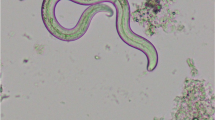Summary
The effects of diethylcarbamazine citrate and thiabendazole on Toxocara canis larvae in mice have been examined in order to test the suitability of this host and parasite for evaluating compounds of potential anthelmintic activity.
Statistical evaluation of the results obtained with both anthelmintics showed that activity can be detected from a comparison of the numbers of larvae within the brains of the treated mice with those within the brains of untreated controls without recourse to examination of their carcasses. The method by which the screen is routinely operated in the authors laboratory for evaluating compounds of potential activity is described.
The results also showed that diethylcarbamazine citrate when administered by either the subcutaneous or oral routes proved to be effective in reducing the numbers of larvae recoverable from both the brains and carcasses of experimentally infected mice. A higher level of activity was obtained when the anthelmintic was administered during the period after infection in which the larvae were migrating through the viscera than when they were established in the brain and skeletal musculature. Thiabendazole when administered subcutaneously during the same period after infection showed a significant but lesser degree of activity. No significant reduction in larval numbers were obtained when this anthelmintic was given orally.
Similar content being viewed by others
References
Beaver, P. C.: Parasitological reviews, Larva migrans. Exp. Parasit. 5, 587–621 (1956).
Campbell, W. C., and A. C. Cuckler: Thiabendazole treatment of the invasive phase of experimental trichinosis in swine. Ann. trop. Med. Parasit. 56, 500–505 (1962).
— Effect of thiabendazole upon the enteral and parenteral phases of trichinosis in mice. J. Parasit. 50, 481–488 (1964).
Duguid, I. M.: Chronic endopthalmitis due to Toxocara. Brit. J. Ophthal. 45, 705–711 (1961a).
— Features of ocular infestation by Toxocara. Brit. J. Ophthal. 45, 789–796 (1961b).
Egerton, J. R.: The effect of thiabendazole upon Ascaris and Stephanurus infections. J. Parasit. 47, (4 sect 2) 37 (1961).
Gibson, T. E.: Toxocara canis as a hazard to public health. Vet. Rec. 72, 772–774 (1960).
Leland, S. E., and G. E. Combs: Tests of anthelmintic activity (utilizing experimental challenge) against the migratory stages of Strongyloides ransomi in pigs. Amer. J. vet. Res. 26, 932–938 (1965).
McManus, E. C., F. V. Washko, and P. J. Tocco: Gastro-intestinal absorption and secretion of thiabendazole in ruminants. Amer. J. vet. Res. 849–855 (1966).
Oshima, T.: Standardization of techniques for infecting mice with Toxocara canis and observations on the normal migration routes of the larvae. J. Parasit. 47, 652–656 (1961).
Pike, E. H.: Effect of diethylcarbamazine, oxyphenarsine hydrochloride, and piperazine citrate on Toxocara canis in mice. Exp. Parasit. 9, 223–232 (1960).
Siegel, S.: Nonparametric statistics for the behavioural sciences, p. 116–127. New York: McGraw Hill Book Co. 1956.
Sprent, J. F. A.: Observations on the development of Toxocara canis (Werner 1782) in the dog. Parasitology 48, 184–209 (1958).
—: Post-parturient infection of the bitch with Toxocara canis. J. Parasit. 47, 284 (1961).
Taylor, J. H.: Toxocara infections in man and animals. Vet. Bull. (Weybridge) 34, 633–637 (1964).
Woodruff, A. W., B. Bisseru, and J. C. Bowe: Infection with animal helminths as a factor causing poliomyelitis and epilepsy. Brit med. J. 1996 I, 1576–1579.
—, and C. K. Thacker: Infection with animal helminths. Brit. med. J. 1964 I, 1001–1005.
Author information
Authors and Affiliations
Rights and permissions
About this article
Cite this article
Burren, C.H. Experimental toxocariasis. Z. F. Parasitenkunde 30, 162–170 (1968). https://doi.org/10.1007/BF00259725
Received:
Issue Date:
DOI: https://doi.org/10.1007/BF00259725




